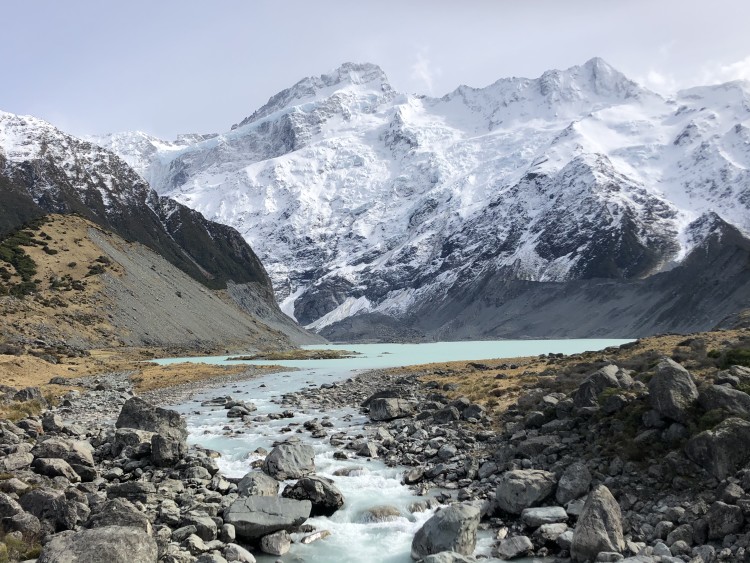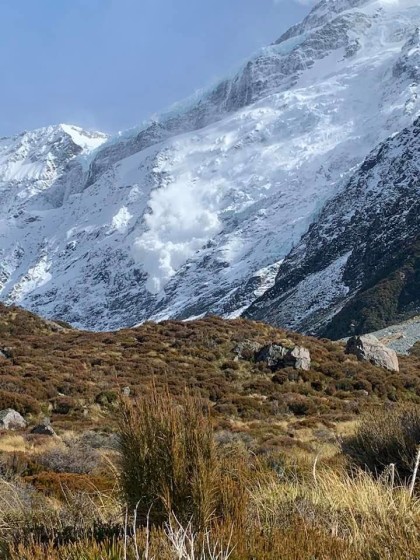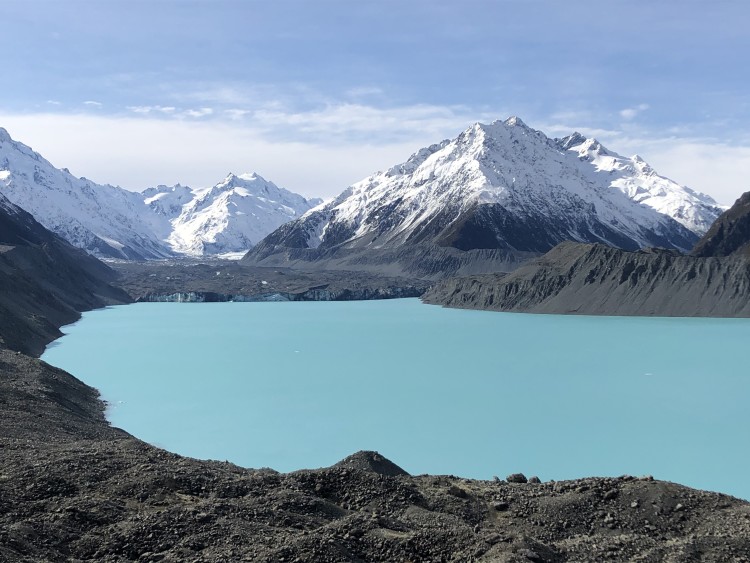Aoraki/Mt Cook National Park is beautiful this time of year. It’s early spring so the weather is starting to warm up, bringing higher temperatures and sunshine, though not enough to melt the thick winter snows. A birthday trip last September was my first time staying overnight in the park and I fell in love with the beautiful alpine landscapes.

The drive from Christchurch to Mt Cook takes about four hours so if you leave on a Friday afternoon you’ll arrive at The Hermitage Hotel by 6pm. It's a similar drive time from Dunedin and Queenstown.
There are other places to stay besides the Hermitage but this historic hotel sits facing Mt Cook and almost all the rooms have windows looking out on the mountain. It’s a tall building, built to withstand a punishing mountain climate and looks a bit like a fortress from a distance, clad in black iron. Built in 1958, the stone walls, exposed wooden beams and lofty ceilings give it a real mountain lodge feel - and turns out it's a super snug place to be on a cold spring night.
It was starting to get dark by the time we parked and shivered our way through big glass doors into the lobby, where an open fire was crackling merrily away. From the check-in area we could see through to the bar where a grand piano sat in the corner and floor-to-ceiling windows framed a view of Mt Cook looming like a ghost above the alpine plains. I couldn't wait to see what things looked like in daylight.

When we wake up on Saturday morning there’s a bit of cloud and patches of blue sky; it looks pretty promising on the weather front. We’re on the top floor in room 1101 and it has a little balcony on the side facing a steep, bush-clad mountainside – the kind you expect a kea to come flying out of at any moment.
The picture window at the front of the room looks straight out at Aoraki/Mt Cook, our highest mountain - all 3,754m of it. The view is incredible, it feels just like you’re inside a postcard.
Our plan is to do the famous three-hour return walk up the Hooker Valley to the base of Aoraki. But first there's breakfast in the sun, right under the dining room windows, looking out and marvelling at the scenery in between mouthfuls of fresh fruit and muesli, eggs, toast and coffee.
By the time we drive to the campground carpark where the track starts, it’s 11am and a strong wind is gusting but it’s not cold; we even have to take our jackets off halfway and the wind adds freshness and drama to the walk.

In spite of the closed borders it’s busy but not crowded – Saturday of course but kiwis are definitely getting out and seeing the country - and why wouldn't you? In 2019 more than a million visitors came through Mt Cook National Park - I can only imagine how packed it would be in non-Covid times. The track is well-formed and mostly flat, making it accessible for all ages and fitness levels.
It’s such a big landscape to be walking through! Giant boulders the size of houses jut out of the Hooker River and the glacial water rushes down towards Lake Pukaki. Scree slopes rise steeply on the right, scored with uniform lines like a Japanese gravel garden.
The mountains on our left provide startling new vistas as we round corners until at one point - while I’m examining a directional compass stationed above a stream - an avalanche tumbles down! I turn around to see plumes of snow falling and puffing out the mountain’s flanks, a thundering noise giving a hint of its power. Imagine being in one of those! Pretty frightening.

There’s a mountain cairn near the start of the track dedicated to mountaineers lost on Aoraki/Mt Cook and it’s covered on two sides with plaques. Many of the names belong to young people in their twenties and thirties and several make reference to avalanches. In fact the memorial was originally built in remembrance of a group lost in an avalanche on February 22, 1914.
We have lunch at a picnic table near the lake at the mountain’s base - it’s pretty chilly this close to all that snow and ice! Then we retrace our steps back to the carpark and have plenty of time to drive 10km down the valley to check out the famous Tasman Glacier.
A steep climb up many steps gets us to the lookout point - about 20 minutes of steady huffing and puffing but it’s well worth it. The lake is a vivid turquoise, long and thin with the receding glacier (disappearing at 480-880m each year!) lying at one end like an icy dragon and at the other a couple of giant icebergs. Two tiny yellow rafts go motoring out closer to the bergs, dwarfed by the size of the lake, the rocky shore and tall mountains all around.

How lucky are we to have these amazing mountains just four hours away from the city! A spring trip to Mt Cook is a just the thing to blow out those winter cobwebs - and if you go in November the Mt Cook lily will be flowering, making it even more special.
Did you know?
- Mt Cook Village has a small school, the only school in New Zealand inside a national park. At the start of 2021 there were nine students from three countries enrolled.
- The first Hermitage Hotel was a cob building built in 1884.
- Mt Cook is surrounded by 20 peaks that are higher than 3000m.
